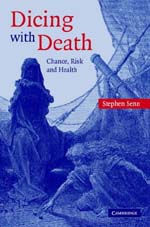'Dicing with death'

Dicing with death: chance, risk and health
"Dicing with Death" is a rarity: a book about statistics for the general public. Popular maths books are no longer uncommon, popular books on the physical sciences became a publishing phenomenon with Stephen Hawking, but popular statistics books are few and far between. Perhaps this fact is related to the poor public image of statistics, although it is difficult to say which is cause and which effect.According to Senn, the popular picture of statisticians is of "squares who go round counting things", which he obviously thinks is very unfair. And instead of whining he has set out to correct this image: "The truth must out, and I am determined to out it."
His subject matter is "the contribution that the science of statistics has made and is making to the life sciences, in particular medicine", and his audience is the general reader - the "nonscientist in the street". Topics covered include "paradoxes in probability, significance tests, clinical trials, the Bayesian and frequentist schools of inference, the generalisability of results, the safety, or otherwise, of medicines and tobacco, life-tables and survival analysis, the summarising of evidence, the mathematics of measles and even the application of statistics to the law". No special mathematical knowledge is needed for most of the book, and the reader has the blessing of the author to skip the two more mathematical chapters.
Senn clearly doesn't subscribe to the "short cuts make long delays" school of writing. Ads for French films, jokes, a Welsh legend or two, all make their way into the book, along with some history and biography and plenty of personal anecdote (the problem with being Swiss, the stupidity of journalists). The style can be summed up with the quote: "[Q]uite frankly, if I cannot indulge a Shandy-like passion for hobby-horses then there is no fun in writing a book like this."
And Senn certainly seems to have had fun, indulging himself in flights of fancy and metaphor - some rather startling: "If mathematics is the handmaiden of the sciences, statistics is its whore: all that scientists are looking for is a quick fix without the encumbrance of a meaningful relationship." However, there is plenty of solid stuff mixed in with the fun.
If you would like to persuade people that "statisticians count", why not take the easy way out and give them this book?
- Book details:
- Dicing with Death: Chance, Risk and Health
- Stephen Senn
- hardback - 250 pages; paperback - 264 pages (2003)
- Cambridge University Press
- ISBN: 0521832594 (hardback); 0521540232 (paperback)
Helen Joyce is editor of Plus. She is also editor of Significance, the magazine of the Royal Statistical Society, for which she wrote this review. It appears here by kind permission of the RSS.